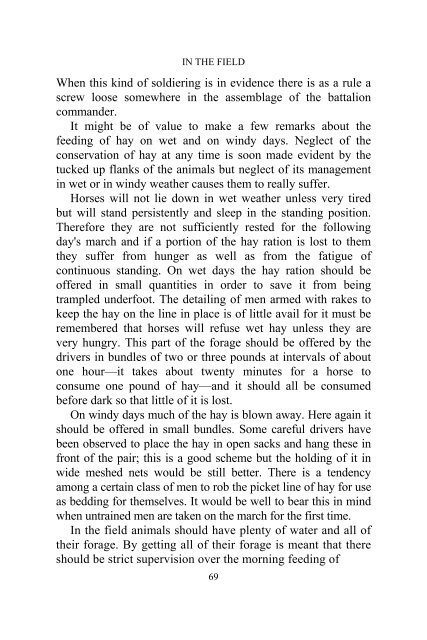the field artillery journal - Fort Sill - U.S. Army
the field artillery journal - Fort Sill - U.S. Army
the field artillery journal - Fort Sill - U.S. Army
Create successful ePaper yourself
Turn your PDF publications into a flip-book with our unique Google optimized e-Paper software.
IN THE FIELD<br />
When this kind of soldiering is in evidence <strong>the</strong>re is as a rule a<br />
screw loose somewhere in <strong>the</strong> assemblage of <strong>the</strong> battalion<br />
commander.<br />
It might be of value to make a few remarks about <strong>the</strong><br />
feeding of hay on wet and on windy days. Neglect of <strong>the</strong><br />
conservation of hay at any time is soon made evident by <strong>the</strong><br />
tucked up flanks of <strong>the</strong> animals but neglect of its management<br />
in wet or in windy wea<strong>the</strong>r causes <strong>the</strong>m to really suffer.<br />
Horses will not lie down in wet wea<strong>the</strong>r unless very tired<br />
but will stand persistently and sleep in <strong>the</strong> standing position.<br />
Therefore <strong>the</strong>y are not sufficiently rested for <strong>the</strong> following<br />
day's march and if a portion of <strong>the</strong> hay ration is lost to <strong>the</strong>m<br />
<strong>the</strong>y suffer from hunger as well as from <strong>the</strong> fatigue of<br />
continuous standing. On wet days <strong>the</strong> hay ration should be<br />
offered in small quantities in order to save it from being<br />
trampled underfoot. The detailing of men armed with rakes to<br />
keep <strong>the</strong> hay on <strong>the</strong> line in place is of little avail for it must be<br />
remembered that horses will refuse wet hay unless <strong>the</strong>y are<br />
very hungry. This part of <strong>the</strong> forage should be offered by <strong>the</strong><br />
drivers in bundles of two or three pounds at intervals of about<br />
one hour—it takes about twenty minutes for a horse to<br />
consume one pound of hay—and it should all be consumed<br />
before dark so that little of it is lost.<br />
On windy days much of <strong>the</strong> hay is blown away. Here again it<br />
should be offered in small bundles. Some careful drivers have<br />
been observed to place <strong>the</strong> hay in open sacks and hang <strong>the</strong>se in<br />
front of <strong>the</strong> pair; this is a good scheme but <strong>the</strong> holding of it in<br />
wide meshed nets would be still better. There is a tendency<br />
among a certain class of men to rob <strong>the</strong> picket line of hay for use<br />
as bedding for <strong>the</strong>mselves. It would be well to bear this in mind<br />
when untrained men are taken on <strong>the</strong> march for <strong>the</strong> first time.<br />
In <strong>the</strong> <strong>field</strong> animals should have plenty of water and all of<br />
<strong>the</strong>ir forage. By getting all of <strong>the</strong>ir forage is meant that <strong>the</strong>re<br />
should be strict supervision over <strong>the</strong> morning feeding of<br />
69

















